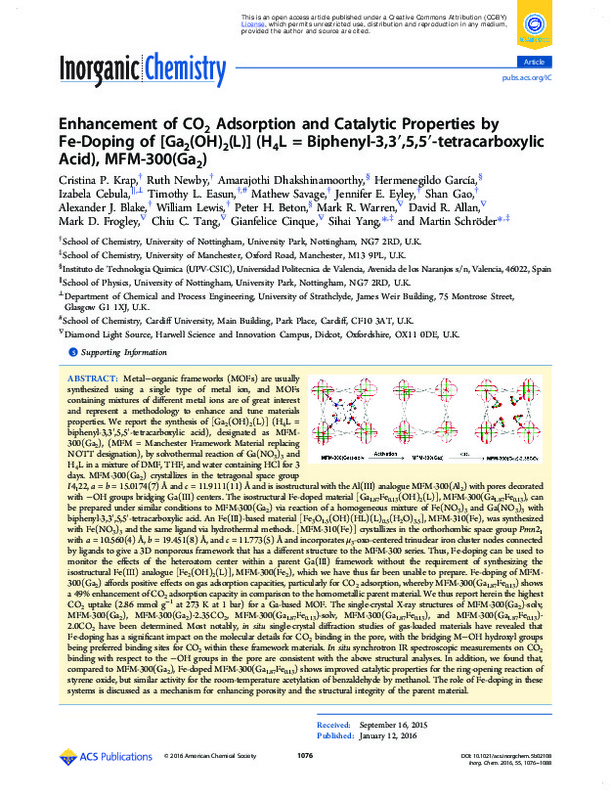|
Resumen:
|
Metal-organic frameworks (MOFs) are usually synthesized using a single type of metal ion, and MOFs containing mixtures of different metal ions are of great interest and represent a methodology to enhance and tune materials ...[+]
Metal-organic frameworks (MOFs) are usually synthesized using a single type of metal ion, and MOFs containing mixtures of different metal ions are of great interest and represent a methodology to enhance and tune materials properties. We report the synthesis of [Ga-2(OH)(2)(L)] (H4L = biphenyl-3,3',5,5'-tetracarboxylic acid), designated as MFM-300(Ga-2), (MFM = Manchester Framework Material replacing NOTT designation), by solvothermal reaction of Ga(NO3)(3) and H4L in a mixture of DMF, THF, and water containing HCl for 3 days. MFM-300(Ga-2) crystallizes in the tetragonal space group I4(1)22, a = b = 15.0174(7) angstrom and c = 11.9111(11) angstrom and is isostructural with the Al(III) analogue MFM-300(Al-2) with pores decorated with -OH groups bridging Ga(III) centers. The isostructural Fe-doped material [Ga1.87Fe0.13(OH)(2)(L)], MFM-300(Ga1.87Fe0.13), can be prepared under similar conditions to MFM-300(Ga-2) via reaction of a homogeneous mixture of Fe(NO3)(3) and Ga(NO3)(3) with biphenyl-3,3',5,5'-tetracarboxylic acid. An Fe(III)-based material [Fe3O1.5(OH)(HL)(L)(0.5)(H2O)(3.5)], MFM-310(Fe), was synthesized with Fe(NO3)(3) and the same ligand via hydrothermal methods. [MFM-310(Fe)] crystallizes in the orthorhombic space group Pmn2(1) with a = 10.560(4) angstrom, b = 19.451(8) angstrom, and c = 11.773(5) angstrom and incorporates mu(3)-oxo-centered trinuclear iron cluster nodes connected by ligands to give a 3D nonporous framework that has a different structure to the MFM-300 series. Thus, Fe-doping can be used to monitor the effects of the heteroatom center within a parent Ga(III) framework without the requirement of synthesizing the isostructural Fe(III) analogue [Fe-2(OH)(2)(L)], MFM-300(Fe-2), which we have thus far been unable to prepare. Fe-doping of MFM-300(Ga-2) affords positive effects on gas adsorption capacities, particularly for CO2 adsorption, whereby MFM-300(Ga1.87Fe0.13) shows a 49% enhancement of CO2 adsorption capacity in comparison to the homometallic parent material. We thus report herein the highest CO2 uptake (2.86 mmol g(-1) at 273 K at 1 bar) for a Ga-based MOF. The single-crystal X-ray structures of MFM-300(Ga-2)-solv, MFM-300(Ga-2), MFM-300(Ga-2)center dot 2.35CO(2), MFM-300(Ga1.87Fe0.13)-solv, MFM-300(Ga1.87Fe0.13), and MFM-300(Ga1.87Fe0.13)center dot 2.0CO(2) have been determined. Most notably, in situ single-crystal diffraction studies of gas-loaded materials have revealed that Fe-doping has a significant impact on the molecular details for CO2 binding in the pore, with the bridging M-OH hydroxyl groups being preferred binding sites for CO2 within these framework materials. In situ synchrotron IR spectroscopic measurements on CO2 binding with respect to the -OH groups in the pore are consistent with the above structural analyses. In addition, we found that, compared to MFM-300(Ga-2), Fe-doped MFM-300(Ga1.87Fe0.13)
shows improved catalytic properties for the ring-opening reaction of styrene oxide, but similar activity for the room-temperature acetylation of benzaldehyde by methanol. The role of Fe-doping in these systems is discussed as a mechanism for enhancing porosity and the structural integrity of the parent material.
[-]
|
|
Agradecimientos:
|
We thank the Universities of Nottingham and Manchester for support. M.S. acknowledges receipt of an ERC Advanced Grant and EPSRC Programme Grant. We also thank EPSRC for funding of X-ray equipment. We acknowledge the use ...[+]
We thank the Universities of Nottingham and Manchester for support. M.S. acknowledges receipt of an ERC Advanced Grant and EPSRC Programme Grant. We also thank EPSRC for funding of X-ray equipment. We acknowledge the use of instrumentation within the Nottingham Nanotechnology and Nanoscience Centre, and thank Dr. Christopher Parmenter for assistance. We thank Conacyt, Mexico, for funding to C.P.K. We are especially grateful to Diamond Light Source for access to Beamlines Ill (EE8943), 119 (MT7548, MT8448, MT8937), and B22 (SM11279).
[-]
|









